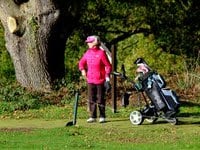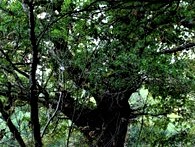Wildlife Conservation: Good or Bad for Golf Courses?
This article is reproduced by kind permission of Keith Duff, retired Chief Scientist with English Nature and now Environment Consultant. It was first published in the Golf Club Secretary newsletter in December 2022 (keithduff21@hotmail.co.uk)
Wildlife on golf courses is one of those things that sparks very different reactions among golfers, and sometimes even golf club managers, excluding, of course, the enlightened readers of The Golf Club Secretary! Many golfers (perhaps even most) don’t give it a second thought, preferring instead to think about who won their roll-up last week or wondering about their handicap. Some see it as a distraction from their game and want to know why the greens staff don’t cut down all that long grass and gorse in which they keep losing their balls. However, a smaller but growing number of golfers see the roughs as an important home for animals and plants, which are becoming increasingly uncommon in the countryside generally, and also appreciate the contribution that such areas make to the overall setting of the golf course. With golf courses being increasingly in the spotlight from people who think they are a much better place than farmland on which to put solar farms, or who consider that they use too much water and chemicals, being able to demonstrate the direct environmental benefits from golf courses becomes ever more urgent.
In our densely populated island, especially in the southern half of England, we have lost huge amounts of natural habitat to housing development and its supporting infrastructure. What little that remains is very fragmented so that it is, in effect, a series of small ‘islands’, often so far apart that animals and plants can’t travel between them, meaning that over time species become inbred, lose vigour and are gradually lost. Even the network of nature reserves and protected areas is not exempt from these effects, and conservationists now put considerable effort into establishing wildlife corridors and ‘stepping stones’ to improve the capacity of species to move between remnant areas of good habitat.
Golf courses have an important role to play here, especially in urban areas, since they provide large areas of green space, which have the potential to act as stepping stones between wildlife reservoirs. But they have the potential to be far more than that, and many golf courses are, in fact, themselves key places for wildlife. Over 100 courses in England are designated as Sites of Special Scientific Interest because of the habitats and species they contain, and over half of these are sufficiently important to have been designated as European protected sites. In these instances, it’s what happens in the roughs that matters, not how the playing areas are managed, and in the vast majority of cases there is a good working relationship between the golf club and the regulator, to their mutual advantage.
But it’s not just those clubs with wildlife designations on their property who manage their roughs in environmentally beneficial ways. There is now much wider recognition that it’s the character of the roughs that defines the golf course itself, whether it’s a heathland course framed by heather and acid grassland, a links course with tall grass roughs and damp areas in lower-lying areas, a parkland or downland course with meadow roughs or a course with extensive areas of water. As well as setting the overall context for golf, these areas are invariably home to a wide variety of plants and animals (often relatively rare species), which themselves add to the enjoyment of the golfing experience for an increasing number of players. It’s not difficult to do what’s necessary in habitat management terms as part of the normal work of the greenkeeping team, and it’s good to see so many clubs recognising this and incorporating it into part of their standard practice.
The animals most frequently noticed on golf courses by players are probably birds and butterflies – and perhaps deer – and if you want to raise your members’ awareness of wildlife on your property this is probably the best place to start. Indeed, most clubs will have a number of members who are interested in these animals and I know of a number of clubs who have a noticeboard on which members put up information on what they’ve seen recently. It’s a good way to start the process of raising more general awareness. But the habitats in your roughs, depending on where you are, will be home to a much more diverse range of animals too – a wide variety of insects (for example, bees, hoverflies, dragonflies, beetles), reptiles and amphibians (snakes, lizards, toads, frogs, newts) and mammals (hedgehogs, hares, squirrels, mice, voles, bats). Most of these are animals that are increasingly hard to see elsewhere in our daily lives.
I wrote a few years ago in The Golf Club Secretary about bumblebees, and how essential they are to the pollination process for crops, as well as for non-cultivated plant species. However, many other types of insect are also vital for pollination, and golf clubs are increasingly playing a key role in this by planting wildflower areas that contain rich nectar sources for pollinators, thus helping sustain and increase populations of these vital animals. You’ll find more information on this on the Operation Pollinator website, or the Bumblebee Conservation Trust website. A number of clubs with either greenkeepers or members who are beekeepers have placed beehives on their land and produce their own honey, some of which is sold in the clubhouse; Cranleigh Golf and Country Club in Surrey, and Stover Golf Club in Devon are good examples.
A less-often-seen, but equally important, feature on golf courses is the so-called ‘veteran tree’. These are ancient trees that are several hundred years old and are often of cultural significance. They also provide homes and places of refuge for rare species of bats, beetles and other invertebrate animals. They are characteristic of ancient forests, such as Sherwood or Savernake, but are also found in long-established parklands. Golf courses that are located in old parkland environments will sometimes retain veteran trees; Edgbaston Golf Club in Birmingham is a good example. If you have such examples on your course it would be wise to seek advice from BIGGA about how best to protect both trees and golfers; BIGGA has a dedicated Ecological Advisor (James Hutchinson) who specialises in veteran trees on golf courses.
If you or your greens team would like some external advice about how best to maintain or improve the quality of your rough management, there are lots of consultants who can help. However, there are other options that you may also want to consider. I know of several clubs who have established very good working relationships with their local county wildlife trust, through which they receive valuable practical advice at little or no cost. Northamptonshire County Golf Club works closely with the Northamptonshire Wildlife Trust (who happen to manage an area of woodland which abuts the golf course) and has improved the quality of its grass heath roughs by cutting and collecting the arisings. The outcome has been a much greater diversity of grasses and wildflowers, which provides more, and better, habitat for pollinators, reptiles and other animals. The Wildlife Trust also carries out recording and surveys of plants, fungi and birds on the golf course, including locations, which enables the club to understand its site better and tailor its management accordingly, especially for sensitive species.
A recent initiative in Leicestershire and Rutland has brought together representatives from over ten clubs, along with the Leicestershire & Rutland Wildlife Trust, to share experience on environmental management on golf courses, including a series of information resources. The group doesn’t just include greenkeepers, but also committee members and club managers from several clubs, which is a good model for the industry more widely. This begins to address one of the biggest challenges in making golf more sustainable – how to engage effectively with golfers and committees, rather than just greenkeepers and club managers. Their website provides more information (Google ‘Greenergolf’).
We all appreciate that the operating environment for golf is already challenging, and the only certainty is that it’s going to get harder. Pressure from escalating energy prices, cost inflation on course management materials (sands, top dressings, water, chemicals), and the impacts of our changing climate mean that finding more sustainable ways of managing the golfing estate is essential. Reducing golf’s environmental footprint is vital and improving the naturalistic management of the roughs will help, both directly and by demonstrating that the industry is a good environmental steward.








